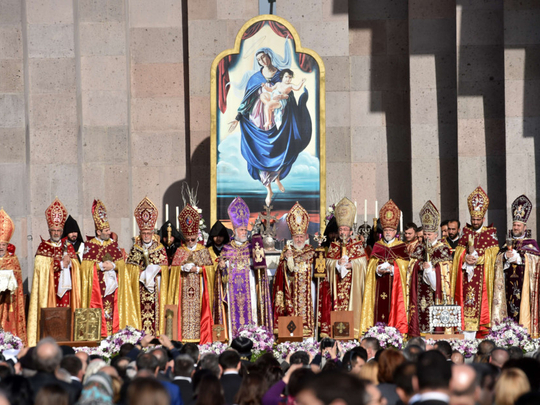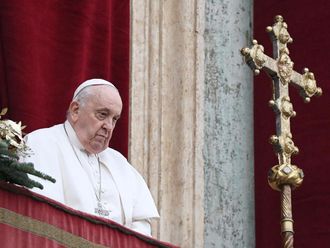
Yerevan: According to the Armenian historian Agathangelos, supposedly a secretary of Tiridates III (r. 287-330), King of Armenia, the first Armenian Catholicos St. Gregory the Illuminator, built special chapels on the graves of the virgins Hripsime and Gayane who were martyred.
This started the tradition of canonization in the fourth century. Today, the church continued in this most solemn custom, after a quarter century debate that crossed and every t and dotted every i to ensure respect to existing regulations. A full-fledged internal debate started in 1989 when the two branches of the Armenian Apostolic Church held an ecumenical gathering and, a year later, which coincided with the 75th anniversary of the Armenian Massacres, preparatory work started to fulfill the required religious canonization processes.
On Thursday evening, and in the presence of 30 leading religious leaders from around the world, a solemn canonization ceremony was held at Etchmiadzin, the seat of the Apostolic Church near Yerevan.
In addition to the Coptic Pope Tawadros II, Cardinal Ra’i and Patriach Nerses Bedros XVI of Lebanon, the heads of the Syrian, Malankara, Greek, Russian, Bulgarian, Serbian, and Slovakian Orthodox churches were in attendance too. So were numerous Archbishops and Bishops, including those of Washington and London, the General Secretary of the World Council of Churches, and many others.
The moving ceremony, with church leaders in full regalia that recalled past era, highlighted the holy mass. Several thousand believers attended too. A rare moment of unity was on full display as the two Apostolic clerics celebrated mass together as dignitaries watched in earnest. “The Armenian people,” intoned the leading cleric, “is a nation devoted to divine will, ready to sacrifice their lives to remain true to the Creator.”
“This,” he continued, “earned them the privilege of canonization.” The ceremony saw various relics on display led by the right hand of St. Gregory the Illuminator, which symbolizes the highest spiritual authority, was paraded in front of the public.
As a sign of rebirth, and despite a rainy weather prediction, the sun was out and the sky was truly blue. Many saw a good omen as the faithful prayed together for the eternal rest of their fallen brethren.












